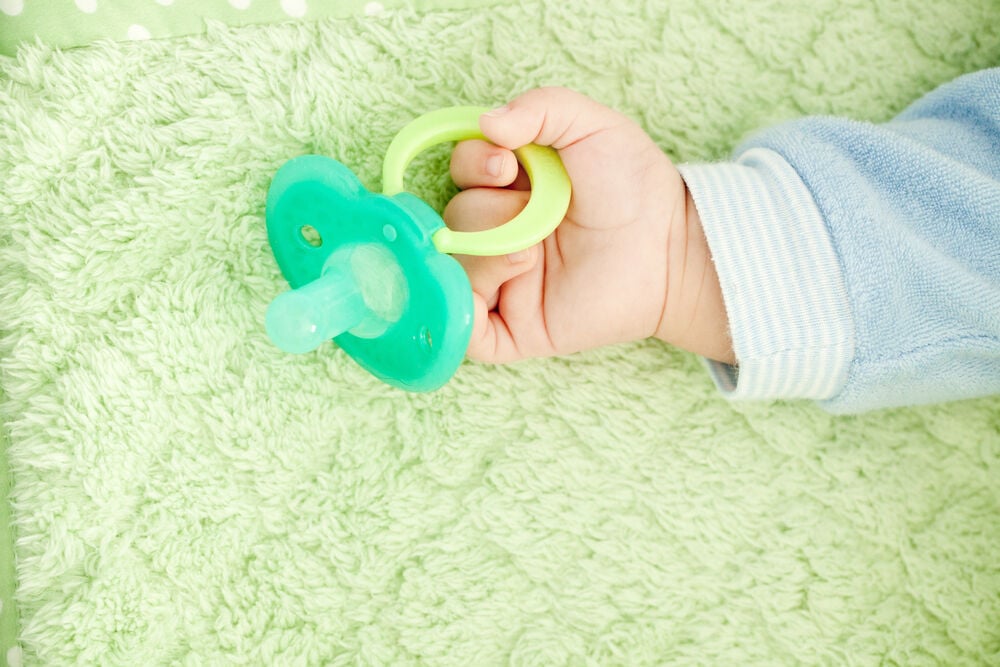Whether or not to give your baby a pacifier is up to you. It can be very soothing for your baby and stop them from crying. Baby pacifiers can be completely safe if they are used and handled properly. This guide will provide the information you need to make a decision about using pacifiers and describe the different types available.
-
Tracking cycle
-
Getting pregnant
-
Pregnancy
-
Help Center
-
Flo for Partners
-
Anonymous Mode
-
Flo app reviews
-
Flo Premium New
-
Secret Chats New
-
Symptom Checker New
-
Your cycle
-
Health 360°
-
Getting pregnant
-
Pregnancy
-
Being a mom
-
LGBTQ+
-
Quizzes
-
Ovulation calculator
-
hCG calculator
-
Pregnancy test calculator
-
Menstrual cycle calculator
-
Period calculator
-
Implantation calculator
-
Pregnancy weeks to months calculator
-
Pregnancy due date calculator
-
IVF and FET due date calculator
-
Due date calculator by ultrasound
-
Medical Affairs
-
Science & Research
-
Pass It On Project New
-
Privacy Portal
-
Press Center
-
Flo Accuracy
-
Careers
-
Contact Us
Baby Pacifiers: A Parents' Guide to Proper Use of Rubber Dummies


Every piece of content at Flo Health adheres to the highest editorial standards for language, style, and medical accuracy. To learn what we do to deliver the best health and lifestyle insights to you, check out our content review principles.
Why do babies like pacifiers so much?
When a baby is born, they have a powerful sucking reflex that allows them to breastfeed without any difficulties. You may have seen an ultrasound picture of a baby sucking their thumb while still in utero. From this very early age, the act of sucking is soothing to your baby, and the use of a pacifier can help calm them.
Pacifiers and teethers: what's the difference?
There are different types of pacifiers and products that resemble pacifiers for older babies beginning to teeth. There are a few differences between the products, including when best to use them.
Pacifiers are intended for your baby to suck on like they would a breast or bottle. Pacifiers aren't designed to be chewed on. If your baby chews on a pacifier, they can accidentally bite a piece off, creating a choking hazard.
Teething pacifiers are made with a much harder material that is often solid. They are designed to hold up even when a baby with a few teeth starts chewing on them. Teethers are more challenging to suck on, so they aren't as good at soothing babies as pacifiers.
Baby pacifiers: pros and cons
Here are some of the pros and cons of using a pacifier.
They can be very soothing for a baby who is tired or not feeling well.
Pros:
- They can provide temporary distraction for your baby at a doctor's appointment or when you're trying to change their diaper.
- They can help a baby fall asleep. Recent research also shows that using pacifiers may reduce the risk of sudden infant death syndrome.
- Pacifiers can be thrown away when you want to wean your baby off them. You can't do this with a thumb!
Cons:
- For breastfed babies, pacifiers shouldn't be used before you've established a good breastfeeding routine. If you introduce a pacifier before your baby is 4–6 weeks old, it can discourage proper breastfeeding.
- Pacifiers can increase your baby's risk of ear infections and mouth sores.
- If a pacifier is used for a long time, your baby can become dependent on it, making it harder to wean them off it.
- Prolonged use of a pacifier can cause dental issues. Most medical professionals suggest that you start weaning your baby off a pacifier when they turn two and complete the process no later than their fourth birthday. The American Academy of Family Physicians recommends at least limiting pacifier use starting when your baby is 6 months old in order to decrease the risk of ear infections.
Pacifiers and teeth development
Recent studies have shown that using pacifiers can increase the risk of a malocclusion (when the top and bottom teeth don't align correctly). This is even more evident when a baby uses a pacifier beyond the recommended age. Some of these same studies also suggest that using an orthodontic pacifier can help reduce this risk in children 2–3 years old.
Baby pacifier types
Take a quiz
Find out what you can do with our Health Assistant

There are lots of different types of baby pacifiers available. Your baby will also have their own opinion!
Orthodontic pacifiers
Orthodontic pacifiers are designed to fit the shape of your baby's mouth. This natural shape mimics the shape of a human nipple. This type of baby pacifier offers room in your baby's mouth for their tongue to move around. It also promotes a natural jaw position and teeth development.
Teething pacifier
Teething pacifiers may look like baby pacifiers, but they are designed for babies to chew on when they are cutting new teeth. Unlike a regular pacifier, they are made from a solid material that is harder and may have ridges. They are made to withstand being chewed on.
One-piece baby soother
The baby soother style of pacifier is likely to be the first type of pacifier that you'll encounter. They are the type most widely used by hospitals around the world. This is the type of pacifier that is recommended for breastfed infants, and the one-piece design makes it easy to keep clean.
Multiple-piece pacifier
Many pacifiers are available in a multiple-piece design. They come in different colors and may even have designs on them. They are more difficult to keep clean, because the gaps between connected pieces can collect bacteria and other organisms. They can also come apart, creating a choking hazard.
Silicon pacifiers
Pacifiers made from silicone are your best bet. The medical-grade material assures that your baby will not be allergic to the product.
Latex pacifiers
There are latex pacifiers available, but some babies are allergic to latex. If your baby is allergic to latex, they may develop symptoms including rash, bumps, blisters, swelling, coughing, runny nose, wheezing, and difficulty breathing.
Round-tip baby soother
Studies and experts suggest that this type of pacifier is best for babies who are born prematurely (especially before 30 weeks). The pacifier length is shorter, and the design is similar to a newborn's thumb. This design can help preterm babies develop a strong sucking reflex, like sucking on their thumb in utero.
Baby pacifiers: dos and don'ts
The use and care of pacifiers are relatively straightforward.
DO:
- Keep it clean. Wash the pacifier in very hot or boiling water (some are dishwasher safe).
- Inspect it regularly for any cracks or loose pieces.
- Choose a one-piece design made of silicone to avoid allergy and choking risks.
- Offer a pacifier after the baby has been fed.
DON'T:
- "Clean" the pacifier in your mouth. By doing so, you can pass infections to your baby.
- Put anything on the baby pacifier (e.g. sugar) to make it more appealing.
- Tie a baby pacifier to the crib. Pacifier leads should be short and have a clip or snap that opens easily to prevent injury.
- Give your breastfed baby a pacifier before they are 4–6 weeks old.
- Use it as the first line of defense when your baby is fussy. Try something else first.
- Force a pacifier on a baby. If they don't want it or if it falls from their mouth when they are asleep, do not put it back.
How to control the use of baby pacifier
A pacifier should not be in use continuously. It should be a tool that is used when your baby is tired or fussy and nothing else has worked to soothe them. Allowing your toddler to walk around with a pacifier in their mouth all the time can make it harder to wean them off it later.
How to wean a baby from a pacifier
Most babies will stop using pacifiers on their own by the time they are between 2 and 4 years old. However, some will try to hold onto it for as long as possible. This is when the benefits no longer outweigh the risks of continued use. Your child will probably need some help breaking this habit. Offer them praise when they choose not to use their pacifier. If your child is struggling to give up the pacifier and you have run out of ideas, consider talking to your child's doctor for suggestions.
Many parents feel that if you don't offer a pacifier, the baby won't become dependent on it and will learn other ways to comfort themselves. Other parents wouldn't dream of going through the first year or two with a new baby and no pacifier. The choice to use a pacifier is up to you and your baby. If you choose to offer your baby a pacifier, follow the tips above to make sure you're doing it in a way that best supports your baby's growth and development.


Hey, I'm Anique
I started using Flo app to track my period and ovulation because we wanted to have a baby.


The Flo app helped me learn about my body and spot ovulation signs during our conception journey.


I vividly
remember the day
that we switched
Flo into
Pregnancy Mode — it was
such a special
moment.
Real stories, real results
Learn how the Flo app became an amazing cheerleader for us on our conception journey.




